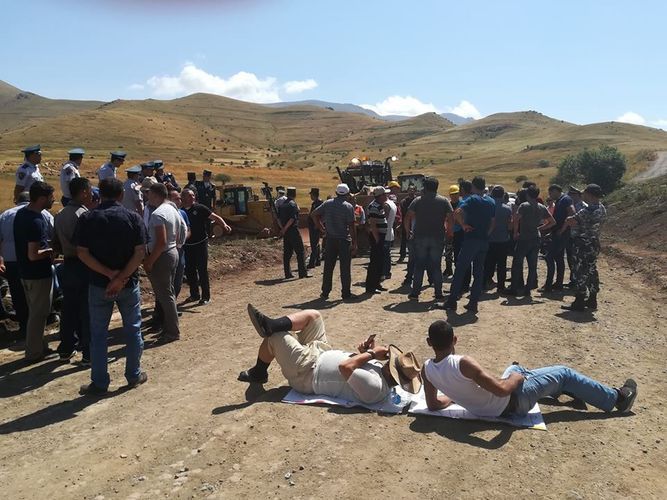
Amulsar Gold Mine poses a serious threat to the Caspian Sea basin
Recently, the issue has become especially acute in connection with the environmental problem in The Caspian Sea. The Caspian Sea is a unique reservoir with its hydrocarbon resources and biological wealth, which has no analogue in the world. According to environmentalists, the sea is poisoned by a large number of heavy metals, which pose the same danger to human health as hydrocarbons. More than 20 million people live on the shores of the Caspian Sea, which are more dependent on the natural resources of the basin. In addition, protecting the Caspian environment is not only a matter of ecology but also an important condition for reducing the risks of deterioration of the health of the coastal population and sustainable economic development, including tourism.
Following the collapse of the USSR, beginning in the 90s of the last century, the Republic of Armenia played a special role in the pollution of the Caspian Sea and the ecology of the South Caucasus. Pollution local (internal rivers of Armenia) and transboundary rivers by industrial enterprises of Armenia causes enormous damage to the ecology of the Caspian Sea, primarily the ecosystems of Iran and Azerbaijan.
Moreover, recently in Armenia the number of industrial enterprises polluting the region’s ecosystem has been increasing. Until recently, the Zangezur Copper-Molybdenum Combine played a special role in this. But now, according to the forecasts of Armenian ecologists, the Amulsar gold mine will play the main role in environmental pollution.
It should be recalled that the issue of exploiting the Amulsar gold ore deposit in southern Armenia does not leave the agenda of the Armenian media, local and international ecologists. According to local activists, if the Armenian government advocates for the hundreds of millions of dollars that the Amulsar field supposedly will bring to the treasury and also, which will lead to the development of the mining industry, then ecologists trumpet the danger of pollution of nearby rivers and the oxidation of Lake Sevan.
It should be recalled that the issue of exploiting the Amulsar gold mine in southern Armenia does not leave the agenda of the Armenian media, local and international ecologists. According to local activists, if the Armenian government advocates for the hundreds of millions of dollars that the Amulsar mine supposedly will bring to the treasury and also, which will lead to the development of the mining industry, then ecologists trumpet the danger of pollution of nearby rivers and the oxidation of Lake Sevan.
Gold was discovered In Amulsar, in 2006. Exploration work has been conducted by the British-American company Lydian Armenia for more than 10 years, which in 2016 began preparations for the development of the mine. The Amulsar mine is located in the valley of the Arpachay and Vorotan rivers, which fall into the Araz river, and it, in turn, into the Caspian.
Two years ago, local environmentalists blocked entry into the mine. Then the Pashinyan government, under pressure from local activists and rallies against the exploitation of the mine in Yerevan, froze the project and announced its intention to conduct a new examination assessing the risk of developing the Amulsar field. On the initiative of the government, the Armenian Investigative Committee opened a criminal case under Article 282 of the RA Criminal Code on concealing or intentionally misrepresenting information about environmental pollution. But, that time-out, which was then taken by the RA government, was just a performance of Pashinyan. Before coming to power, Nikol Pashinyan promised his foreign partners that he would remove all restrictions as soon as possible and contribute to the operation of the mine. Otherwise, what caused the Prime Minister of Armenia to come to Dzhemruk in the summer of 2019, to go around all the houses in the area and try to change the opinions of residents about the development of the mine. Then the locals of Dzhemruk made Pashinyan understand that they are categorically against the exploitation of Amulsar, substantiating their decision with the fact that the city is a resort. Then one of the local residents, Gohar Hunanyan, who repatriated from the USA, said that she has many friends who want to follow her example and they hope that Armenia will remain a country with a clean environment.
In March 2019, Lydian mining company warned the Armenian government of plans to appeal to the international arbitration court in connection with the illegal blockade of roads leading to the Amulsar gold mine. Then, according to local media, Lydian Armenia prepared a lawsuit in the London International Arbitration Court against the Armenian authorities demanding payment of $ 2 billion. The justification of the claim, according to media reports, was the fact that the Armenian authorities, from the point of view of the company, cannot provide acceptable working conditions, as a result, the enterprise incurs millions of losses. After these reports, the Armenian government made decision in favor of the British - American company.
By the way, according to some sources, the President of Armenia Armen Sargsyan also has a share in the Amulsar field.
Thus, on August 15, 2019, as part of the criminal proceedings, the UK issued the conclusion of the international expert group Earth Link & Advanced Resources Development (ELARD). It follows from the document that there are no environmental threats from the development of Amulsar, and the possible risks are controlled. On the same day, environmentalists and citizens took to the streets. Despite the statement by Prime Minister N. Pashinyan that the field of work should be resumed, mass protests in the Jermuk region and Yerevan led to the postponement of the project.
According to the chairman of the Consumer Advisory Center Karen Chilingaryan, the new authorities in Armenia did not choose the advanced path of economic development, but the development of mineral resources, and recalls that the intensive, sometimes uncontrolled operation of mines has already led to disastrous results for the environment. Moreover, in his opinion, the damage that can be caused to the environment is not comparable with the state’s profit from the exploitation of deposits.
Just the other day, a report prepared by the EU delegation on the possible operation of the Amulsar gold mine in Jermuk was published on the Open Democracy portal. According to the report, the Armenian government, and Prime Minister N. Pashinyan are under severe pressure from the governments of Great Britain and the United States in connection with their position regarding the Amulsar Gold Mine.
Note that back in August 2019, the Investigative Committee of the Republic of Armenia published a report on the study of the Amulsar field, conducted by the ELARD consulting company. Based on the results of the investigation, the committee concluded that the Amulsar Gold Mine could pollute river networks in the region with production waste.
Amulsar gold mine can poison the entire basin of the Caspian Sea, polluting the rivers flowing through the territory of Azerbaijan. According to a joint study by the Armenian Ecological Front and international experts, with the start of the project, acids, metals, sulfates, nitrates and other harmful substances will be dumped into the Yachmen and Vorotan rivers.
As a result of the project, the merger of the Arpa River and the Vorotan River in the occupied territories with the Araz River, which flows into the Caspian Sea, in Nakhchivan will cause serious damage to the environment of the Islamic Republic of Iran, as well as Azerbaijan. This means that the problem has already reached a global scale.
As the head of the Center for Environmental Studies of the Academy of Sciences of Armenia, Doctor of Geological Sciences Armen Saghatelyan assures, the company did not assess three very important risks: acid drainage, mobilization of toxic substances and microseismicity. He notes that nature does not have a self-cleaning mechanism from heavy metals, and the effect of toxic products manifests itself after decades in the form of oncological diseases, reproductive and hereditary functions.
The risky initiative to develop the Amulsar gold mine is not the only Armenian project that poses a danger to the ecology of the South Caucasus. The fact that there are other states in the region that are not obliged to feel the environmental consequences of the irresponsible actions of the Armenian leadership in Yerevan is not always remembered. Among such dangerous projects - the operation of the nuclear power plant in Metsamor, which gives the Republic’s 40% of the electricity it consumes. Armenia also controls the resources of the Sarsang reservoir located in the occupied Azerbaijani territories deliberately pollutes the rivers flowing from the territory of Armenia to Azerbaijan.
This is direct terrorism in relation to the Azerbaijani population by Armenia. The UN Economic Commission for Europe Convention on the Protection and Use of Transboundary Watercourses and International Lakes, known as the UN Water Convention, which was adopted in Helsinki in 1992 and entered into force in 1996, also states this. Almost all countries with transboundary waterways in the UNECE region are parties to the agreement. The “UN Water Convention” requires member states to prevent, control and reduce transboundary impact, use transboundary waters wisely and fairly, ensuring sustainable management.
Touching upon the issue, back in 2017, the ex-head of the press service of the Ministry of Foreign Affairs of Azerbaijan Hikmet Hajiyev in an interview with 1news.az stated that “despite the refusal to join the UN Water Convention, Armenia has obligations under a number of other international agreements. In particular, according to the Helsinki Rules of 1966 and the Berlin Rules of 2004 on the use of waters of international rivers, according to the resolution of the UN General Assembly on transboundary waters, according to the PACE resolution on transboundary water basins in Europe and other international documents.”
H. Hajiyev called deliberate pollution of the rivers flowing through Armenia to Azerbaijan, as well as full control over the Sarsang reservoir, which is located in the Azerbaijani territories captured by Armenia, another direction of environmental terror against Azerbaijan.
Moreover, it's not forgotten the resolution entitled "Intentional deprivation of water for residents of the border regions of Azerbaijan", which was adopted in January 2017 by the PACE. The resolution published by the Parliamentary Assembly of the Council of Europe (PACE) said that the most important Sarsang reservoir, due to the lack of regular maintenance for more than 20 years, creates a "danger to the entire border region."
The PACE statement read that the malfunction of the reservoir, which is located in Nagorno-Karabakh and is controlled by the Armenians, could lead to "a major disaster with large casualties and, possibly, a new humanitarian crisis." The resolution states the need for unhindered access by independent engineers and hydrologists to check and assess the situation on the Sarsang reservoir, as well as international monitoring of the functioning of irrigation canals.
Summing up this topic, I hope that the neighboring and Caspian countries, realizing the danger of environmental terror, elevated to the rank of state policy in Armenia, will force this country to comply with international law accepted in a civilized society.



